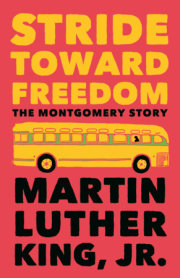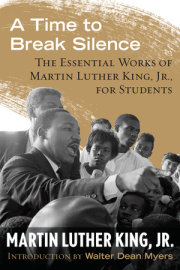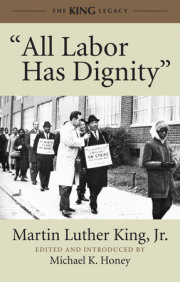From Chapter III: The Decisive Arrest On December 1, 1955, an attractive Negro seamstress, Mrs. Rosa Parks, boarded the Cleveland Avenue bus in downtown Montgomery. She was returning home after her regular day’s work in the Montgomery Fair, a leading department store. Tired from long hours on her feet, Mrs. Parks sat down in the first seat behind the section reserved for whites. Not long after she took her seat, the bus operator ordered her, along with three other Negro passengers, to move back in order to accommodate boarding white passengers. By this time every seat in the bus was taken. This meant that if Mrs. Parks followed the driver’s command she would have to stand while a white male passenger, who had just boarded the bus, would sit. The other three Negro passengers immediately complied with the driver’s request. But Mrs. Parks quietly refused. The result was her arrest.
There was to be much speculation about why Mrs. Parks did not obey the driver. Many people in the white community argued that she had been “planted” by the NAACP in order to lay the groundwork for a test case, and at first glance that explanation seemed plausible, since she was a former secretary of the local branch of the NAACP. So persistent and persuasive was this argument that it convinced many reporters from all over the country. Later on, when I was having press conferences three times a week— in order to accommodate the reporters and journalists who came to Montgomery from all over the world—the invariable first question was: “Did the NAACP start the bus boycott?”
But the accusation was totally unwarranted, as the testimony of both Mrs. Parks and the officials of the NAACP revealed. Actually, no one can understand the action of Mrs. Parks unless he realizes that eventually the cup of endurance runs over, and the human personality cries out, “I can take it no longer.” Mrs. Parks’s refusal to move back was her intrepid affirmation that she had had enough. It was an individual expression of a timeless longing for human dignity and freedom. She was not “planted” there by the NAACP, or any other organization; she was planted there by her personal sense of dignity and self-respect. She was anchored to that seat by the accumulated indignities of days gone by and the boundless aspirations of generations yet unborn. She was a victim of both the forces of history and the forces of destiny. She had been tracked down by the zeitgeist—the spirit of the time.
Fortunately, Mrs. Parks was ideal for the role assigned to her by history. She was a charming person with a radiant personality, soft-spoken and calm in all situations. Her character was impeccable and her dedication deep-rooted. All of these traits together made her one of the most respected people in the Negro community.
Only E. D. Nixon—the signer of Mrs. Parks’s bond— and one or two other persons were aware of the arrest when it occurred early Thursday evening. Later in the evening the word got around to a few influential women of the community, mostly members of the Women’s Political Council. After a series of telephone calls back and forth they agreed that the Negroes should boycott the buses. They immediately suggested the idea to Nixon, and he readily concurred. In his usual courageous manner he agreed to spearhead the idea.
Early Friday morning, December 2, Nixon called me. He was so caught up in what he was about to say that he forgot to greet me with the usual “hello” but plunged immediately into the story of what had happened to Mrs. Parks the night before. I listened, deeply shocked, as he described the humiliating incident. “We have taken this type of thing too long already,” Nixon concluded, his voice trembling. “I feel that the time has come to boycott the buses. Only through a boycott can we make it clear to the white folks that we will not accept this type of treatment any longer.”
I agreed at once that some protest was necessary, and that the boycott method would be an effective one. Just before calling me Nixon had discussed the idea with Rev. Ralph Abernathy, the young minister of Montgomery’s First Baptist Church who was to become one of the central figures in the protest, and one of my closest associates. Abernathy also felt a bus boycott was our best course of action. So for thirty or forty minutes the three of us telephoned back and forth concerning plans and strategy. Nixon suggested that we call a meeting of all the ministers and civic leaders the same evening in order to get their thinking on the proposal, and I offered my church as the meeting place. The three of us got busy immediately. With the sanction of Rev. H. H. Hubbard—president of the Baptist Ministerial Alliance—Abernathy and I began calling all of the Baptist ministers. Since most of the Methodist ministers were attending a denominational meeting in one of the local churches that afternoon, it was possible for Abernathy to get the announcement to all of them simultaneously. Nixon reached Mrs. A. W. West—the widow of a prominent dentist—and enlisted her assistance in getting word to the civic leaders.
By early afternoon the arrest of Mrs. Parks was becoming public knowledge. Word of it spread around the community like uncontrolled fire. Telephones began to ring in almost rhythmic succession. By two o’clock an enthusiastic group had mimeographed leaflets concerning the arrest and the proposed boycott, and by evening these had been widely circulated.
As the hour for the evening meeting arrived, I approached the doors of the church with some apprehension, wondering how many of the leaders would respond to our call. Fortunately, it was one of those pleasant winter nights of unseasonable warmth, and to our relief, almost everybody who had been invited was on hand. More than forty people, from every segment of Negro life, were crowded into the large church meeting room. I saw physicians, schoolteachers, lawyers, businessmen, postal workers, union leaders, and clergymen. Virtually every organization of the Negro community was represented.
The largest number there was from the Christian ministry. Having left so many civic meetings in the past sadly disappointed by the dearth of ministers participating, I was filled with joy when I entered the church and found so many of them there; for then I knew that something unusual was about to happen.
Had E. D. Nixon been present, he would probably have been automatically selected to preside, but he had had to leave town earlier in the afternoon for his regular run on the railroad. In his absence, we concluded that Rev. L. Roy Bennett—as president of the Interdenominational Ministerial Alliance—was the logical person to take the chair. He agreed and was seated, his tall, erect figure dominating the room.
The meeting opened around seven-thirty with H. H. Hubbard leading a brief devotional period. Then Bennett moved into action, explaining the purpose of the gathering. With excited gestures he reported on Mrs. Parks’s resistance and her arrest. He presented the proposal that the Negro citizens of Montgomery should boycott the buses on Monday in protest. “Now is the time to move,” he concluded. “This is no time to talk; it is time to act.”
So seriously did Bennett take his “no time to talk” admonition that for quite a while he refused to allow anyone to make a suggestion or even raise a question, insisting that we should move on and appoint committees to implement the proposal. This approach aroused the opposition of most of those present, and created a temporary uproar. For almost forty-five minutes the confusion persisted. Voices rose high, and many people threatened to leave if they could not raise questions and offer suggestions. It looked for a time as though the movement had come to an end before it began. But finally, in the face of this blistering protest, Bennett agreed to open the meeting to discussion.
Immediately questions began to spring up from the floor. Several people wanted further clarification of Mrs. Parks’s actions and arrest. Then came the more practical questions. How long would the protest last? How would the idea be further disseminated throughout the community? How would the people be transported to and from their jobs?
As we listened to the lively discussion, we were heartened to notice that, despite the lack of coherence in the meeting, not once did anyone question the validity or desirability of the boycott itself. It seemed to be the unanimous sense of the group that the boycott should take place.
The ministers endorsed the plan with enthusiasm, and promised to go to their congregations on Sunday morning and drive home their approval of the projected one-day protest. Their cooperation was significant, since virtually all of the influential Negro ministers of the city were present. It was decided that we should hold a city-wide mass meeting on Monday night, December 5, to determine how long we would abstain from riding the buses. Rev. A. W. Wilson—minister of the Holt Street Baptist Church— offered his church, which was ideal as a meeting place because of its size and central location. The group agreed that additional leaflets should be distributed on Saturday, and the chairman appointed a committee, including myself, to prepare the statement.
Our committee went to work while the meeting was still in progress. The final message was shorter than the one that had appeared on the first leaflets, but the substance was the same. It read as follows:
Don’t ride the bus to work, to town, to school, or any place Monday, December 5.
Another Negro woman has been arrested and put in jail because she refused to give up her bus seat.
Don’t ride the buses to work, to town, to school, or anywhere on Monday. If you work, take a cab, or share a ride, or walk.
Come to a mass meeting, Monday at 7:00 p.m., at the Holt Street Baptist Church for further instruction.
Copyright © 2010 by Martin Luther King, Jr.. All rights reserved. No part of this excerpt may be reproduced or reprinted without permission in writing from the publisher.










